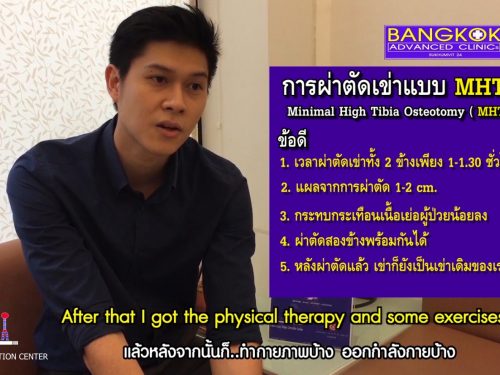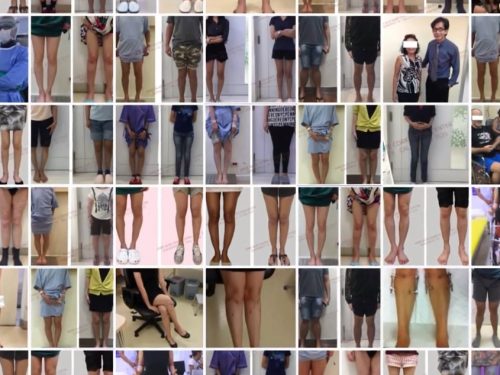
It’s quite common for toddlers to appear mildly bow legged. In fact, toddlers can often have bowed legs that may even interfere with walking. Fortunately, bow legs usually begin to straighten once the child starts to walk and it can be thought of as a natural occurrence that the child will usually grow out of. Adolescents occasionally have bowed legs if the degree of deformation is rather severe which can cause a flaw in their appearance.

What is bowleg knee and knock-knee?
Bowlegs / knees is a condition in which, whilst standing upright, an individual’s legs curve outward in an “O” shape, with an angle at the knees bigger than at the ankles. The curve size is so prominent that you could fit a small ball through the gap.

Knock knee is the condition in which, when a person is standing straight, the knees curve in and touch each other with the legs spreading out from the knee down. This results in the legs having an appearance like the letter “X”
Does the deformity of legs / knees in a child result in long-term harmful effects?

As mentioned earlier in this article, adolescents occasionally have bowed legs if the degree of deformation is severe. This can also cause a flaw in their appearance which is made even more obvious when wearing short trousers, short skirts or close-fitting trousers. Moreover, if there are other negative factors such as being overweight or having weak knee muscles then children can develop knee pain, before age generative knee joints (quicker than usual).
Unfortunately, in adults and adolescents with severe cases of bow-legs, surgery is often the only option. Therefore, taking care and treating the condition from an early age is very important as it ensures the child’s legs and knees grow properly and the need for treatment in future years can be eradicated.
The change in the shape of the legs / knees in developing children

The shape of the legs or knees of children from birth is unstable. Studies have shown that babies legs and knees are not straight. This is especially true for newborn babies. A baby’s legs bend most at birth when the “Tibiofemoral Angle” (the angle curving outward) of the legs between thigh and shank bone, is as high as 15 degrees. Fortunately, this “bending” angle will gradually reduce with age. At 2 years old, the legs / knees will usually straighten up and look normal. However the change does not stop there; from around the age of 2 years old the legs / knees will start to bend inward. This curving in will gradually increase to its full extent at around 3 years old. In some cases, the curving-in angle can be as large as the curving out at birth (about 12-13 degrees).
During this period, when the child is developing and growing at a rapid rate, the curve-in angle is reducing. Later, when the child reaches 6-7 years of age, the bending angle will be smaller (at only a few degrees) which will result in it appearing straight again. The small angle of the curve-in will be stable until the child becomes an adult. Nevertheless, the legs / knees will curve out again later in life, when the person becomes much older because, at around 70 years old, the degeneration of the knee joint can occur.

Increasingly, with both the mother and the father leading busy lives, senior family members are called upon to support the family by looking after the younger children. They may be concerned that the children have bow legs / knees and they often believe that the condition is permanent and will get worse over time. They do not realize that the children will go through this natural development and that the legs will straighten up over time. I would suggest a simple rule of thumb: do not be concerned by a child’s bowed legs up to the age of around 20 months old as this is quite common and the bowlegs / knees will usually straighten up to normal. However, if the child is nearly 2, or more than 2 years old, and the bowed curve is still obvious, then it is necessary to have an appointment with a doctor for a further examination.

If a child of 2-3 years old has bow legs / knees, then there is no need to be overly concerned. Usually, simply waiting for another 1 or 2 years will see the legs / knees curve out less and the legs will straighten up as normal.
If you are concerned about a child having normal legs / knees
For those who are unsure or concerned about their child’s condition, I would suggest the following approach:
Firstly, take the child to see the orthopedic doctor. At this stage it is vitally important that the parents don’t make the child agitated or distressed. For example, in the past, parents have been known to make children unduly worried by stating that the doctor will give them a painful injection; this can have a very negative effect on a child, making them apprehensive about visiting the doctor and too fearful of being examined properly.
Why is the shape of a child’s legs / knees continuously changing?

There are many theories that explain the phenomenon. For example, one theory is of a high accumulation of pressure at the site that builds the shank length. Furthermore, every baby is born with bowlegs (curved out legs / knees) and when they learn to walk the weight will make the legs curve out even more, making the condition even more obvious. This is because the entirety of the body weight will be exerted on to one side of the knees (outside), subsequently; the base of the sole will become narrower and make walking more unstable. Therefore, the child will walk with their legs spread out in order to balance themselves and to prevent themselves from falling. This, in turn, increases the pressure on the bone length building site at the outside more than the inside. The length building site of the inside legs / knees are free from the pressure and can build more length. As a result of this, the legs / knees will become more and more curved until the child reaches 2 years old, when the legs will straighten again. At around the age of 2 years old, the leg length building site of the inside legs / knees continues to grow which makes the knees / legs curve more up to the age of 4.

When the bone length building at the two sides (inside and outside) of the knees is able to balance and the leg walking muscles are more developed, the curving of the knee will gradually be reduced. After a child reaches 6-7 years old, their knee angle will have only a minor change. At around 25 years old, if the knees are not well taken care of, they will curve out. Also, if they are neglected then the knees / legs curving will be even more obvious at an earlier age. Furthermore, the person will easily develop knee pain and degenerative knee symptoms.
Another theory involves the pulling ‘tension’ on the outside and on the inside of the leg muscle. The theory was put forward by one of the most established orthopedic doctors, and a teacher of mine, deputy professor Dr. Pairuch Prasongjean (now retired). He believes that, at the time children start learning how to walk, they will spread out their legs as much as possible in order to make the base of their sole wider, giving them a more stable base to walk upon. In doing so, the walking muscle on the outside will exert a far greater pulling tension on the knee cap than on the inside leg and knee muscle. Consequently, every step a child takes when they put their body weight on the floor, their knee will curve in more and more each time.
Parents and senior relatives who are worried whether a young child will grow up to be an adult with bowed legs / knees should take the child to be evaluated by a doctor. The doctor will make the necessary examinations such as: measuring the angle of the knee, observing the patient’s walking style and investigating others areas. Some will need to take an x-ray to see if the bone length building site is of a normal shape or if it has any abnormality. For children who are more than 2 years old and still have bowed legs / knees, further appointments may be needed where the doctor can make observations over time. Usually this would take place every 6 months until the patient is of normal knee shape according to their age.
For some children, bowed legs can occur from a very young age. This especially occurs in certain nationalities or children who are overweight. The symptoms need to be addressed at an early stage – it is essential that they are treated before it is too late.

Related Articles
Part 1 Bow legs (or bow knees) and knock-knee in children
Part 2 Bow legs (or bow knees) and knock-knee in children





